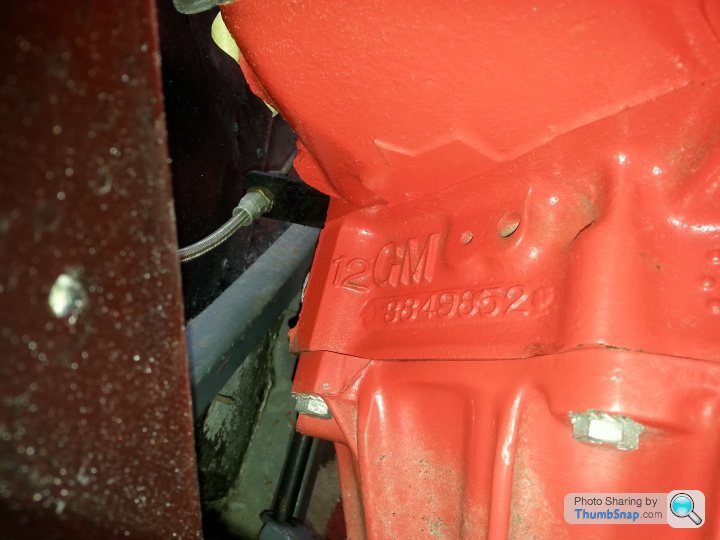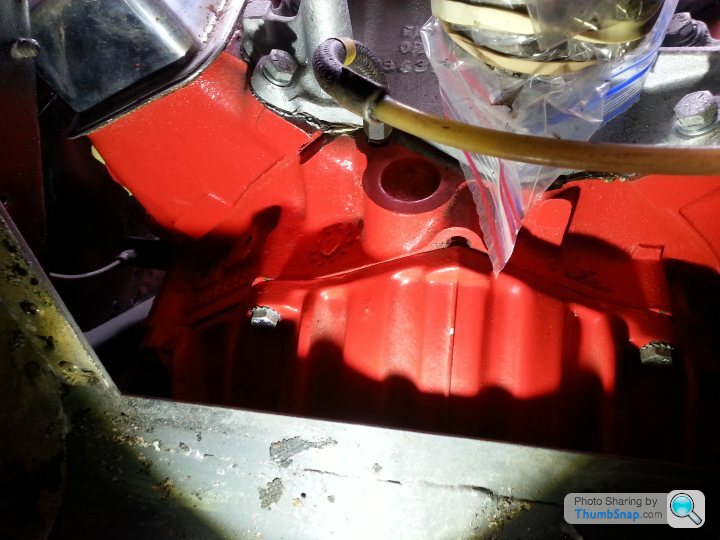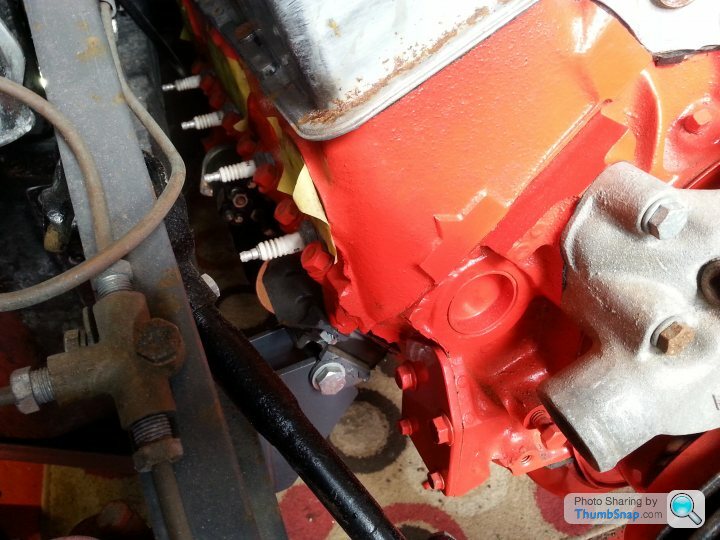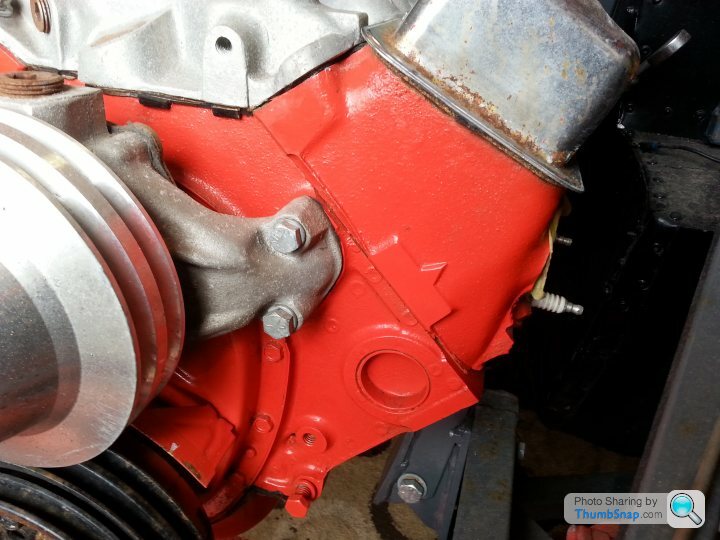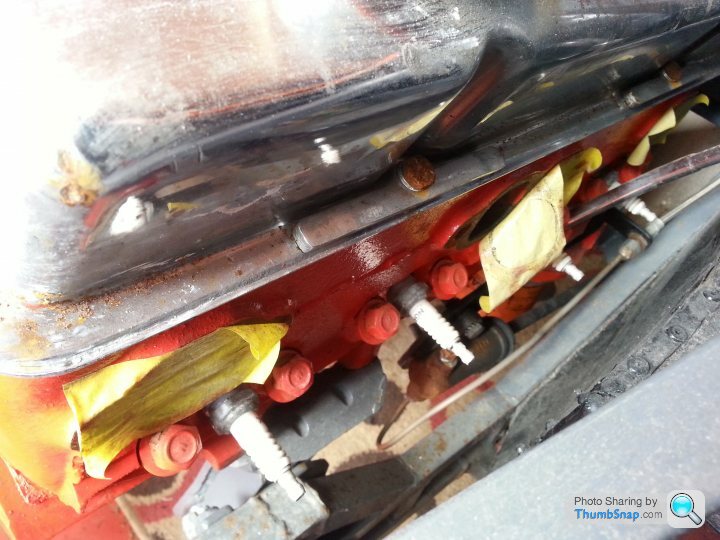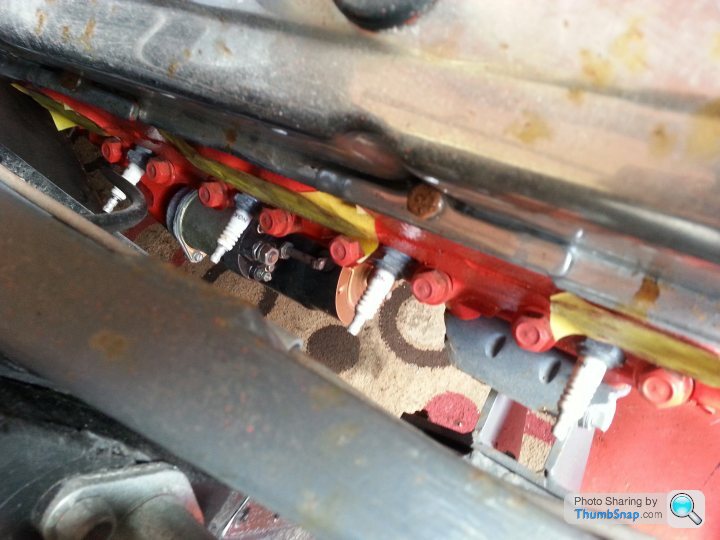V8 Chevy Rebuild
Discussion
ZedLeg said:
Keep it stiff said:
aeropilot said:
Yep, maybe the only part of the original truck motor, is in fact the block..... i.e it was just a replacement for a trashed earlier block.
I would guess for racing purposes, that maybe the case, as a 350ci engine maybe outside the regs?
Trouble is how do you prove that, if some looks at the numbers and moans that you are running a bigger engine than allowed?
Given that this is a unique car I won't be able to get FIA papers for it, this is actually a blessing as it leaves me with a relatively free hand. I have spoken with the organiser of the series I'm likely to race it in and he is pretty relaxed about the engine spec as long as I keep it in period. As such I want to keep steel heads and carb, other than that I can do much as I wish.I would guess for racing purposes, that maybe the case, as a 350ci engine maybe outside the regs?
Trouble is how do you prove that, if some looks at the numbers and moans that you are running a bigger engine than allowed?
I would like to be in the 300 - 350 hp range, I need to be sensible with the budget and in an 800 kilo car any more hp is unlikely to translate into substantially improved times and not least as it will be restricted to driver ability.
I have spoken to a few builders, the guys building engines high spec engines for exotic and valuable historic race cars are out of my league. I have also spoken to a chat who seems to be more on my wavelength, at the moment my plan is to get the engine to him, let him strip it and provide recommendations and estimate.
The world of V8's is completely new to me and I appreciate all the advice.
By the way, I'm looking for a pair of rams horn manifolds, there are no manifolds fitted and very little room. I have spent some time looking through Google images and it looks to me that these might be the best option in confined space. They also offer the advantage of looking suitably period. Does anyone have a pair on the shelf that they might be willing to sell or indeed just let me borrow to see if they fit?
It also depends on how the engine runs atm - if it has good compression all round, no blue smoke and shuts off quickly (indicating still tight in the bores) it might be worth running a season and getting to grips with it, then building a screamer. Keep us posted.
PS, get a copy of this or similar:
https://www.amazon.co.uk/Build-Max-Performance-Blo...
So you have a bit of understanding of these engines. A lot of the info applies to junkyard blocks and dealer parts which we don't get so much here but there will be some relevant info in amongst all that.
PS, get a copy of this or similar:
https://www.amazon.co.uk/Build-Max-Performance-Blo...
So you have a bit of understanding of these engines. A lot of the info applies to junkyard blocks and dealer parts which we don't get so much here but there will be some relevant info in amongst all that.
some bloke said:
It also depends on how the engine runs atm - if it has good compression all round, no blue smoke and shuts off quickly (indicating still tight in the bores) it might be worth running a season and getting to grips with it, then building a screamer. Keep us posted.
PS, get a copy of this or similar:
https://www.amazon.co.uk/Build-Max-Performance-Blo...
So you have a bit of understanding of these engines. A lot of the info applies to junkyard blocks and dealer parts which we don't get so much here but there will be some relevant info in amongst all that.
I will order that book, thanks for the suggestion.PS, get a copy of this or similar:
https://www.amazon.co.uk/Build-Max-Performance-Blo...
So you have a bit of understanding of these engines. A lot of the info applies to junkyard blocks and dealer parts which we don't get so much here but there will be some relevant info in amongst all that.
As I have all of this year to get the car race ready, I would rather go down the route of knowing I have a proven/decent spec engine from the start rather than running the car next year for a trial period with a risk of downtime mid season.
The car will go to a GRP specialist next month, it needs taking back to gel coat, and after that for paint. I will remove the engine before it goes and as there will be plenty of other stuff to be getting on with when the car gets back to me refitting the engine will be a job for the autumn.
Cool - people have been wringing power out of these for nearly 70 years, both low-buck and high buck, so you should be able to get easy, reliable horsepower with a bit of cash and plenty of care.
Years ago my bro in law had a 283 that would regularly spin to 7500rpm, built with factory stamped rockers, cast iron manifold, points ignition. It was balanced and had a ton of compression via shaved head and block. There's plenty of info on these engines on the net as well, with over 108 million built.
Years ago my bro in law had a 283 that would regularly spin to 7500rpm, built with factory stamped rockers, cast iron manifold, points ignition. It was balanced and had a ton of compression via shaved head and block. There's plenty of info on these engines on the net as well, with over 108 million built.
There's a funny thing - the rear bell block casting number indicates:
3849852 57-66 283 car & Truck 2-bolt, from this site:
http://outintheshop.com/faq/casting/castings2.html
Did you get a number stamped on the front RH pad on the block, ie, does it match the one off the paperwork you posted earlier?
3849852 57-66 283 car & Truck 2-bolt, from this site:
http://outintheshop.com/faq/casting/castings2.html
Did you get a number stamped on the front RH pad on the block, ie, does it match the one off the paperwork you posted earlier?
some bloke said:
There's a funny thing - the rear bell block casting number indicates:
3849852 57-66 283 car & Truck 2-bolt, from this site:
http://outintheshop.com/faq/casting/castings2.html
Yep, that's the site I found out mine casting number of 3896944 showed mine was a final year '67 only 283 2-bolt block.3849852 57-66 283 car & Truck 2-bolt, from this site:
http://outintheshop.com/faq/casting/castings2.html
some bloke said:
There's a funny thing - the rear bell block casting number indicates:
3849852 57-66 283 car & Truck 2-bolt, from this site:
http://outintheshop.com/faq/casting/castings2.html
Did you get a number stamped on the front RH pad on the block, ie, does it match the one off the paperwork you posted earlier?
I agree, that number on the block does not seem to relate to the number I posted previously, which was on the paperwork. I have hunted high and low but I can't see any other ID numbers. The only question that matters really is is this engine suitable for rebuild to produce 300 - 350. I'm tied up with other things over the next few weeks, as soon as I get a clear weekend I will be taking it out of the car.3849852 57-66 283 car & Truck 2-bolt, from this site:
http://outintheshop.com/faq/casting/castings2.html
Did you get a number stamped on the front RH pad on the block, ie, does it match the one off the paperwork you posted earlier?
The casting number on the back of the block - your one is 3849852 - tells you a few clues about when the block was made and what vehicle it may have been in. (I seem to remember early 283 blocks were good candidates for punching out to a 4" bore as they had thicker walls) The engine number is stamped on the pad on the front of the engine, left side, as you look at the car from the front. It will be something like the one from your paperwork - VO821UFJ7CJ501965 - but may have been machined off. You may have to scrape the paint off here:
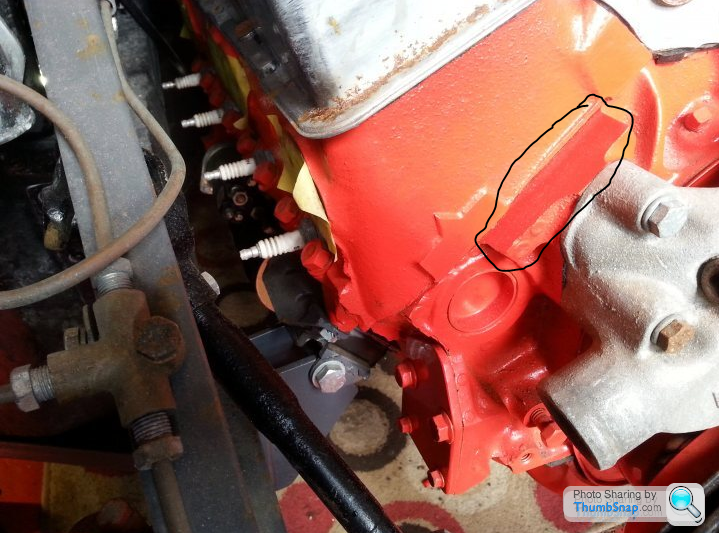
to see if there's a stamped number. That will partly match the VIN of the car it came from. Otherwise you may just have to dismantle it, measure bore and stroke etc and see what you have.
Keep us posted.

to see if there's a stamped number. That will partly match the VIN of the car it came from. Otherwise you may just have to dismantle it, measure bore and stroke etc and see what you have.
Keep us posted.
Could also reveal that it might be a warranty replacement engine, which had a number that included the part number rather than any codes relating to a VIN, as naturally the engine was never originally fitted in a vehicle on a production line, and this was quite common back in the day.
I also believe some engine machine process will damage or make the number unreadable, such as being block decked.
I also believe some engine machine process will damage or make the number unreadable, such as being block decked.
some bloke said:
The casting number on the back of the block - your one is 3849852 - tells you a few clues about when the block was made and what vehicle it may have been in. (I seem to remember early 283 blocks were good candidates for punching out to a 4" bore as they had thicker walls) The engine number is stamped on the pad on the front of the engine, left side, as you look at the car from the front. It will be something like the one from your paperwork - VO821UFJ7CJ501965 - but may have been machined off. You may have to scrape the paint off here:

to see if there's a stamped number. That will partly match the VIN of the car it came from. Otherwise you may just have to dismantle it, measure bore and stroke etc and see what you have.
Keep us posted.
I wire brushed the paint from the area you suggested and it revealed the letter F. No numbers or other letters. Perhaps this was a crate engine and as part of the reprocessing the original block ID was ground off. Anyway, it matters not at this stage, the mystery will need to wait until the strip down.
to see if there's a stamped number. That will partly match the VIN of the car it came from. Otherwise you may just have to dismantle it, measure bore and stroke etc and see what you have.
Keep us posted.
I'm grateful for your, and other responses, much appreciated. I will certainly keep you updated.
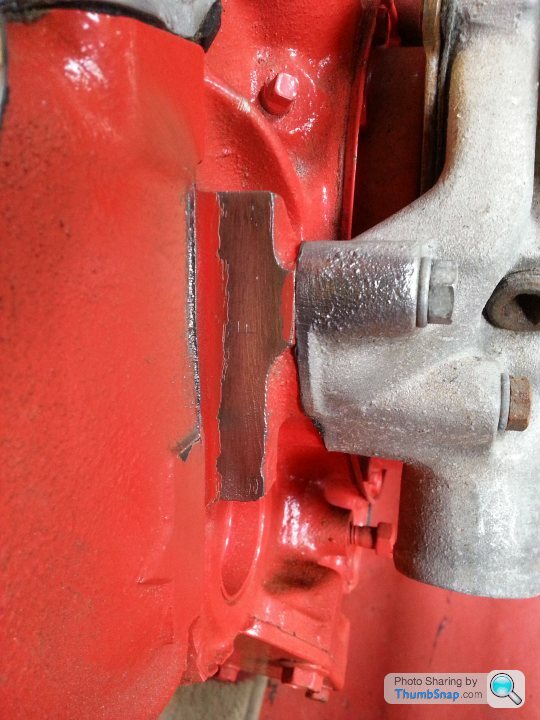
Keep it stiff said:
some bloke said:
The casting number on the back of the block - your one is 3849852 - tells you a few clues about when the block was made and what vehicle it may have been in. (I seem to remember early 283 blocks were good candidates for punching out to a 4" bore as they had thicker walls) The engine number is stamped on the pad on the front of the engine, left side, as you look at the car from the front. It will be something like the one from your paperwork - VO821UFJ7CJ501965 - but may have been machined off. You may have to scrape the paint off here:

to see if there's a stamped number. That will partly match the VIN of the car it came from. Otherwise you may just have to dismantle it, measure bore and stroke etc and see what you have.
Keep us posted.
I wire brushed the paint from the area you suggested and it revealed the letter F. No numbers or other letters. Perhaps this was a crate engine and as part of the reprocessing the original block ID was ground off. Anyway, it matters not at this stage, the mystery will need to wait until the strip down.
to see if there's a stamped number. That will partly match the VIN of the car it came from. Otherwise you may just have to dismantle it, measure bore and stroke etc and see what you have.
Keep us posted.
I'm grateful for your, and other responses, much appreciated. I will certainly keep you updated.

It does look like the original number was ground off for whatever reason, which could have been a legit one, or a less legit one back in the mists of time during the past 5 or more decades.
It is a while since I updated. The car has been away for body restoration. I now need to turn my attention to the motor. The previous owner had fabricated engine mounts however he had put the engine so far back that there was no room to get the manifolds on. I will pull it forward, and perhaps lower, to see how I can overcome this. I have a pair of rams-horn and a tubular pair, I'm not sure either will fit and in which case I will need to get something custom-made. Pulling the engine forward will give me a potential clash of steering column and pump/bottom hose which I will also need to figure out. I will save a bit of space fitting single-belt pulleys.
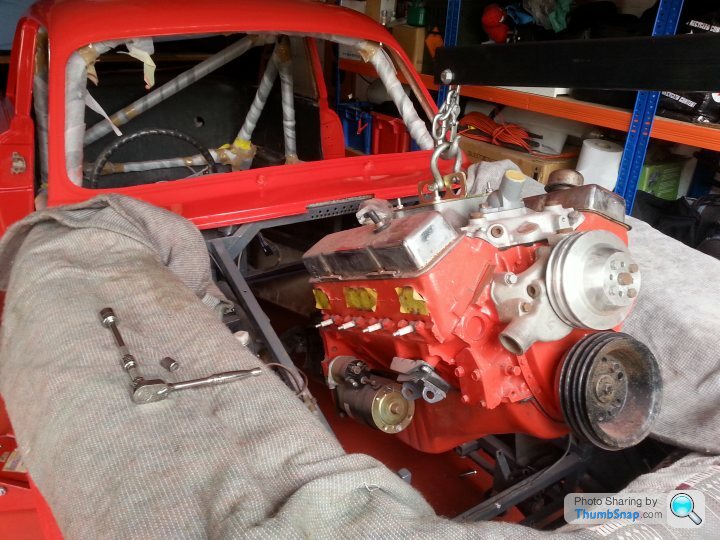



Hi there, this may be a better book than the last one I posted, I'm currently reading it.
How to Hotrod Small-Block Chevys: Covers All Small-Block Engines 1955 Through 1972, 265 Through 400 Cubic Inches https://amzn.eu/d/9vQ8h31
We don't have access to the same high performance parts they did in the US in 1972 but there's lots of good basic info in this one, and it can be had quite cheap.
Keep us updated.
How to Hotrod Small-Block Chevys: Covers All Small-Block Engines 1955 Through 1972, 265 Through 400 Cubic Inches https://amzn.eu/d/9vQ8h31
We don't have access to the same high performance parts they did in the US in 1972 but there's lots of good basic info in this one, and it can be had quite cheap.
Keep us updated.
I’d try and keep a dual row pulley, it gives you extra security for the water pump as the alternator belt is very long. I threw mine at Shelsley last year and didn’t get my award as I was scouring the hill to find the belt!
2 bolt mains may not be the done thing for a high HP small block but plenty of people have used them without issue. I’d strip and rebuild what you’ve got. If you want to splash out I’d spend it on heads. Even a cheap iron head eg Sportsman 2 will give you a fair bump over what you’ve got.
I race a small block Vette and do everything myself so if you need some help let me know.
Oil surge will be your Achilles heel. That’s the bit you really need to get right with a wet sump.
Have you tried a set of standard engine mounts before you go down the fabrication route?
2 bolt mains may not be the done thing for a high HP small block but plenty of people have used them without issue. I’d strip and rebuild what you’ve got. If you want to splash out I’d spend it on heads. Even a cheap iron head eg Sportsman 2 will give you a fair bump over what you’ve got.
I race a small block Vette and do everything myself so if you need some help let me know.
Oil surge will be your Achilles heel. That’s the bit you really need to get right with a wet sump.
Have you tried a set of standard engine mounts before you go down the fabrication route?
Edited by Oneball on Saturday 29th July 10:51
Progress over the weekend. I cut away part of the inner footwells on both sides, I can reinstate later as removable hatches. With the engine on the crane, and the box supported by a trolley jack, I was able to pass the rams horns through the newly cut apertures and fit them. The alternative tubular manifolds had no chance. I then spent ages pulling the engine backwards and forwards, side to side and up and down trying to find the best position. If I retain the rams horns I will need to get the outlets chopped and adapted on both sides, the near side clashes with the slave cylinder and the offside with the chassis. The alternative is to find someone who can make me a tubular pair that require no more space than the rams.
There are other considerations and compromises to find:
1. Engine height needs to be low enough to allow the carb, and ideally a thin pancake, to clear the bonnet whilst leaving me sufficient sump clearance.
2. Engine needs to sit at an angle, offside further forward than nearside, to allow box output flange to line up with diff via a tunnel that is offset.
3. Moving the engine /back, moving it back reduces clash of bottom hose/water pump with steering rack and would be better for weight distribution, bringing it forward clears a bulkhead chassis rail which is helpful to Point 1.
4. Steering column clash, top UJ fouls with manifold, bottom UJ restricts bottom hose. I do have some scope to reposition the rack and I will change the UJs.
5. All of the above would be influenced by how the engine mounts and chassis meet. I purchased two types, a flattish pair and a tripod pair, using the flat ones looks most likely but either way I will need chassis fabrication to make the connection.
Plenty of thinking and trial & error required, next couple of weekends are busy with other things so it will be later in Aug before I can get back to it.
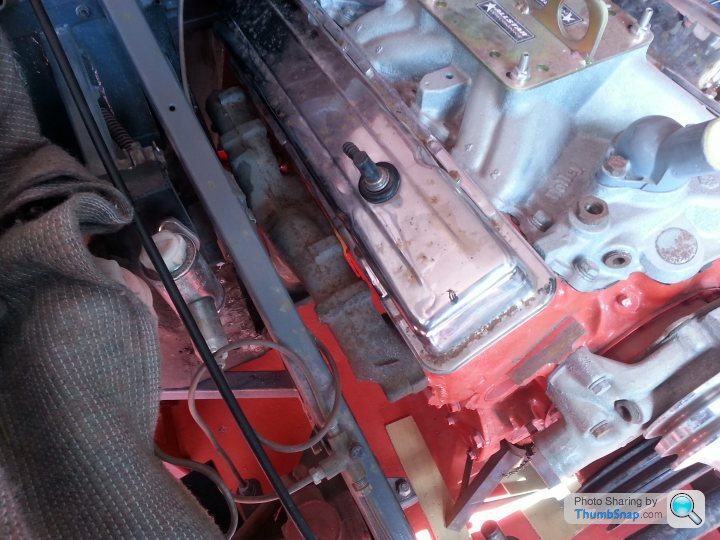
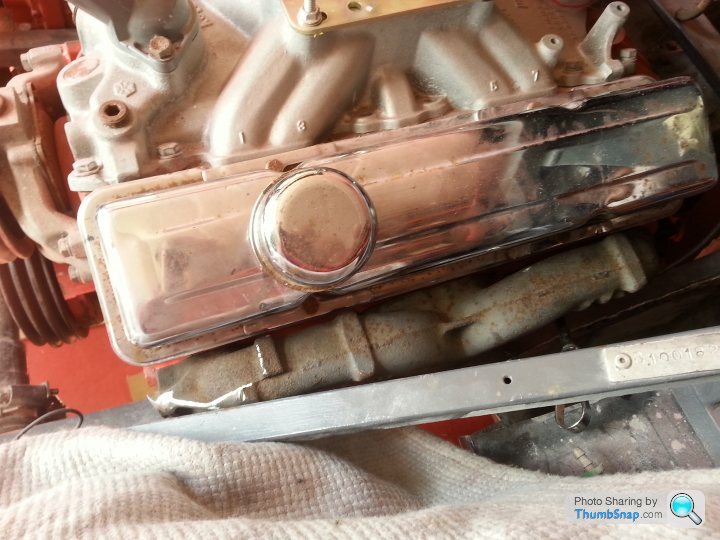
There are other considerations and compromises to find:
1. Engine height needs to be low enough to allow the carb, and ideally a thin pancake, to clear the bonnet whilst leaving me sufficient sump clearance.
2. Engine needs to sit at an angle, offside further forward than nearside, to allow box output flange to line up with diff via a tunnel that is offset.
3. Moving the engine /back, moving it back reduces clash of bottom hose/water pump with steering rack and would be better for weight distribution, bringing it forward clears a bulkhead chassis rail which is helpful to Point 1.
4. Steering column clash, top UJ fouls with manifold, bottom UJ restricts bottom hose. I do have some scope to reposition the rack and I will change the UJs.
5. All of the above would be influenced by how the engine mounts and chassis meet. I purchased two types, a flattish pair and a tripod pair, using the flat ones looks most likely but either way I will need chassis fabrication to make the connection.
Plenty of thinking and trial & error required, next couple of weekends are busy with other things so it will be later in Aug before I can get back to it.


Gassing Station | Yank Motors | Top of Page | What's New | My Stuff





